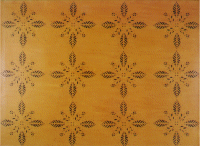

 Floorcloths or "Oylcloths" are first mentioned in Britain in the beginning of
the eighteenth century. They were painted by humble housepainters and often
offered in the classical designs used for marble floors by the fashionable
architects of the day.
Floorcloths or "Oylcloths" are first mentioned in Britain in the beginning of
the eighteenth century. They were painted by humble housepainters and often
offered in the classical designs used for marble floors by the fashionable
architects of the day.
Originally hand painted and stenciled, by the middle of the 18th century
floorcloths began to be printed with hand held wooden blocks. The trade had
become a proper industry with factories springing up in ports such as Dundee and
Bristol as well as London, where the looms used for the weaving of sail cloth
were also used to weave the great widths necessary to cover a large floor
without any seams.
In colonial times, for those who were not able, or did not choose, to import
their carpets, there were several alternate solutions, the most attractive of
which were floorcloths. Floorcloth's were made of canvas cloth, sail cloth or
some other sturdy cloth covered with several coats of paint for durability.
The apogee of floorcloth manufacture was perhaps around the turn of the 18th
and 19th centuries, when many great houses ordered floorcloths for their
entrance halls. At this time companies such as SMITH and BABER of Knightsbridge
did a considerable trade not only in Britain but also abroad, particularly to
America. Although there soon sprung up an American Floorcloth industry to rival
the British, floorcloths continued to be imported to America such as the rare
example still preserved in situ in Natchez, Mississippi, imported in 1849.
The trade continued to flourish throughout the 18th century but the patenting of
linoleum by Frederick Walton in 1860 proved to be a blow from which the industry
was never to recover.
This once flourishing industry has been all but forgotten, mainly because so few
examples have survived. In Britain there are only fragments preserved at Calke
Abbey. American floorcloths survive not only in Natchez but in Colonial
Williamsburg. Perhaps the oldest cloth surviving in situ is the charming
floorcloth in the Swedish Royal Palace of Tullgarn, dating from 1800. This cloth
is not factory manufactured but painted as a one-off. Its existance suggests
that perhaps other cloths were also painted for European palaces at this period.
Disclaimer: The information provided in this article is for general informational purposes only. While we strive to ensure the accuracy and reliability of the information presented, we make no warranties, express or implied, about the completeness, accuracy, reliability, suitability, or availability with respect to the content. Any reliance you place on such information is strictly at your own risk. We recommend consulting with professionals for specific advice tailored to your project’s needs, particularly regarding building codes, regulations, and product specifications.
Under no circumstances shall we be liable for any loss or damage, including without limitation, indirect or consequential loss or damage, arising from the use of, or reliance on, the information provided in this article.